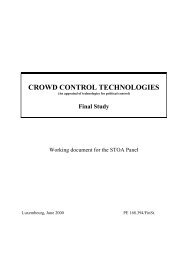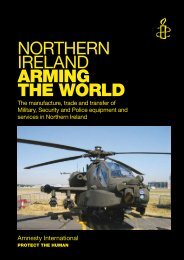Download Stopping the Torture Trade - Omega Research Foundation
Download Stopping the Torture Trade - Omega Research Foundation
Download Stopping the Torture Trade - Omega Research Foundation
Create successful ePaper yourself
Turn your PDF publications into a flip-book with our unique Google optimized e-Paper software.
© Eric Tasden<br />
<strong>Stopping</strong> <strong>the</strong> torture trade<br />
12<br />
such device is <strong>the</strong> restraint chair,<br />
which allows a prisoner’s wrists<br />
and ankles to be secured at <strong>the</strong><br />
same time — known as four-point<br />
restraint. In addition straps can<br />
be tightened across <strong>the</strong> prisoner’s<br />
shoulders and chest. The restraint<br />
chair has been marketed as a<br />
“safer alternative” to o<strong>the</strong>r forms<br />
of four-point restraint.<br />
However, AI has received<br />
reports of restraint chairs being<br />
used in <strong>the</strong> USA to shackle<br />
children and people with physical<br />
disabilities; to punish prisoners<br />
for minor infractions of prison<br />
rules; and to incapacitate<br />
prisoners while <strong>the</strong>y are being<br />
tortured or abused. Most of <strong>the</strong><br />
reported abuses have taken place<br />
in jails, particularly in <strong>the</strong> intake areas.<br />
Some moves have been made to restrict <strong>the</strong> use of restraint<br />
chairs in <strong>the</strong> USA. In August 1999, for instance, a Tennessee<br />
judge ruled that a confession obtained while a suspect was<br />
confined to a restraint chair was inadmissible stating that:<br />
“While such a chair may be useful, it can easily cross <strong>the</strong> line as<br />
a coercive force”. 16 In November 1999 a judge in Ventura County,<br />
California, issued a preliminary injunction banning <strong>the</strong> chair in<br />
<strong>the</strong> county jail after a lawsuit was filed alleging widespread<br />
abuse. 17<br />
In May 2000 <strong>the</strong> UN Committee against <strong>Torture</strong> expressed its<br />
concern that <strong>the</strong> use of restraint chairs may violate <strong>the</strong><br />
Convention against <strong>Torture</strong> and O<strong>the</strong>r Cruel, Inhuman or<br />
Degrading Treatment or Punishment and recommended that <strong>the</strong><br />
USA: “Abolish... restraint chairs as methods of restraining those<br />
in custody. Their use almost invariably leads to breaches of<br />
Article 16 of <strong>the</strong> Convention.” 18<br />
Despite <strong>the</strong> evident risk of injury and abuse, at least one USbased<br />
manufacturer continues to export restraint chairs. AEDEC<br />
A restraint chair




